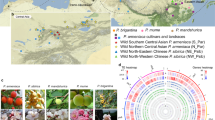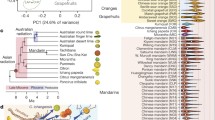Abstract
Parallel Evolution under Domestication and Phenotypic Differentiation of the Cultivated Subspecies of Cucurbita pepo (Cucurbitaceae). Cucurbita pepo (pumpkin, squash, gourd, Cucurbitaceae) is an ancient North American domesticate of considerable economic importance. Based on molecular genetic polymorphisms, two cultivated lineages of this species, each consisting of very many edible–fruited cultigens, have been recognized, C. pepo subsp. pepo and C. pepo subsp. texana. However, the phenotypic commonalities and differences between these two subspecies have not as yet been systematically collected and organized. Among the evolutionary developments common to the two subspecies are the increased size of the plant parts, less plant branching, and premature loss of chlorophyll in the exocarp of the fruits. In both subspecies, bush growth habit, conferred by allele Bu, is common to the cultigens grown for consumption of the immature fruits, as is the deviation from the 1:1 ratio of fruit length to fruit width. A major characteristic differentiating between the edible–fruited cultigens of the respective subspecies are the longitudinal protrusions, in subsp. pepo, versus depressions, in subsp. texana, of the fruit surface corresponding with the subsurface primary carpellary vein tracts. Subsp. pepo also has larger fruits and larger and longer seeds. In addition, some alleles affecting stem color, leaf mottling, multiple flower bud production, and fruit characteristics are frequently occurring to nearly fixed in one subspecies but are rare to less common in the other.



Similar content being viewed by others
Literature Cited
Andres, T. C. 1987. Cucurbita fraterna, the closest wild relative and progenitor of C. pepo. Cucurbit Genetics Cooperative Report 10:69–71.
——— 2000. An overview of the oil pumpkin. Cucurbit Genetics Cooperative Report 23:87–88.
Baggett, J. R. 1972. Open growth habit in summer squash. HortScience 7:288.
Bailey, L. H. 1943. Species of Cucurbita. Gentes Herbarum 6:266–322.
Batson, W. A. 1937. The cucurbits illustrated. J. C. Robinson Seed Co., Waterloo, Nebraska.
Carter, G. F. 1945. Plant geography and culture history in the American southwest. Viking Fund Publications in Anthropology No. 5, New York.
Cook, J. P. 2000. Styrian pumpkin oil: The marketing perspective. Cucurbit Genetics Cooperative Report 23:128.
Cowan, C. W. 1997. Evolutionary changes associated with the domestication of Cucurbita pepo. Pages 63–85 in K. J. Gremillion, ed., People, plants and landscapes: Studies in paleoethnobotany. University of Alabama Press, Tuscaloosa, Alabama.
Decker, D. S. and H. D. Wilson. 1987. Allozyme variation in the Cucurbita pepo complex: C. pepo var. ovifera vs. C. texana. Systematic Botany 12:263–273.
Decker-Walters, D. S. 1990. Evidence for multiple domestications of Cucurbita pepo. Pages 96–101 in D. M. Bates, R. W. Robinson, and C. Jeffrey, eds., Biology and utilization of the Cucurbitaceae. Cornell University Press, Ithaca, New York.
Erwin, A. T. 1931. Nativity of the cucurbits. Botanical Gazette 91:105–108.
Ferriol, M., B. Pico, and F. Nuez. 2003. Genetic diversity of a germplasm collection of Cucurbita pepo using SRAP and AFLP markers. Theoretical and Applied Genetics 107:271–282.
Filov, A. I. 1954. Rukovodstvo po aprobatsyi selskokhozyistvennikh kultur, vol. 6: Bakhcheviye kulturi. Gosudarstvennoye Izdatelstvo Selskokhozyistvennoi Literaturi, Moscow.
Fritz, G. J. 1997. A three–thousand–year–old cache of crop seeds from Marble Bluff, Arkansas. Pages 42–62 in K. J. Gremillion, ed., People, plants and landscapes: Studies in paleoethnobotany. University of Alabama Press, Tuscaloosa, Alabama.
Goldman, A. 2004. The compleat squash. Artisan, New York.
Gong, L., H. S. Paris, M. H. Nee, G. Stift, M. Pachner, J. Vollmann, and T. Lelley. (2012). Genetic relationships and evolution in Cucurbita pepo (pumpkin, squash, gourd) as revealed by simple sequence repeat polymorphisms. Theoretical and Applied Genetics 124.
Heiser, C. B. 1979. The gourd book. University of Oklahoma Press, Norman: Oklahoma.
Jeffrey, C. 2001. Cucurbitaceae. Pages 1510–1557 in P. Hanelt, ed., Mansfeld’s encyclopedia of agricultural and horticultural crops. Springer, Berlin.
Katzir, N., Y. Tadmor, G. Tzuri, E. Leshzeshen, N. Mozes–Daube, Y. Danin–Poleg, and H. S. Paris. 2000. Further ISSR and preliminary SSR analysis of relationships among accessions of Cucurbita pepo. In: Proceedings of Cucurbitaceae 2000, the 7th Eucarpia meeting on cucurbit genetics and breeding, eds. N. Katzir and H. S. Paris. Acta Horticulturae 510:433–439.
Lebeda, A., E. Křistkova, and H. S. Paris. 2010. Variation for morphological traits within and among Cucurbita pepo genotypes. In: Proceedings of the 4th international symposium on cucurbits, ed. X. Sun. Acta Horticulturae 871:211–218.
———, M. P. Widrlechner, J. Staub, H. Ezura, J. Zalapa, and E. Křistkova. 2007. Cucurbits (Cucurbitaceae; Cucumis spp., Cucurbita spp., Citrullus spp.). Pages 271–376 in R. J. Singh, ed., Genetic resources, chromosome engineering, and crop improvement, Vol. 3. CRC Press, Boca Raton, Florida.
Lira, R., T. C. Andres, and M. H. Nee. 1993. Cucurbita, Sechium, Sicana y Cyclanthera. Pages 1–115 in R. Lira, ed., Estudios taxonomicos y ecogeograficos de las Cucurbitaceae Latinoamericanas de importancia economica, Vol. 9. International Plant Genetic Resources Institute, Rome.
——— and S. Montes. 1994. Cucurbits (Cucurbita spp.). Pages 63–77 in J. E. Hernandez and J. Leon, eds., Neglected crops: 1492 from a different perspective. F. A. O, Rome.
Loy, J. B. 2004. Morpho–physiological aspects of productivity and quality in squash and pumpkins (Cucurbita spp.). Critical Reviews in Plant Science 23:337–363.
Nee, M. 1990. The domestication of Cucurbita. Economic Botany 44(3, suppl):56–68.
Paris, H. S. 1986. A proposed subspecific classification for Cucurbita pepo. Phytologia 61:133–138.
——— 1989. Historical records, origins, and development of the edible cultivar groups of Cucurbita pepo (Cucurbitaceae). Economic Botany 43:423–443.
——— 1996. Summer squash: History, diversity, and distribution. HortTechnology 6:6–13.
——— 2000a. Paintings (1769–1774) by A. N. Duchesne and the history of Cucurbita pepo. Annals of Botany 85:815–830.
——— 2000b. History of the cultivar–groups of Cucurbita pepo. Horticultural Reviews 25(2001):71–170. 4 pl.
——— 2002. Characterization of reversed striping in Cucurbita pepo. Pages 36–40 in D. N. Maynard, ed., Cucurbitaceae 2002. American Society for Horticultural Science, Alexandria, Virginia.
——— 2009. Genes for “reverse” fruit striping in squash. Journal of Heredity 100:371–379.
——— 2010. Multiple flowering as an adaptation of summer squash for growing in protected culture. Pages 88–90 in J. Thies, S. Kousik, and A. Levi, eds., Cucurbitaceae 2010. American Society for Horticultural Science, Alexandria, Virginia.
——— and R. N. Brown. 2005. The genes of pumpkin and squash. HortScience 40:1620–1630.
——— and M. Edelstein. 2001. Same gene for bush growth habit in Cucurbita pepo subsp. pepo as in C. pepo subsp. ovifera. Cucurbit Genetics Cooperative Report 24:80–81.
——— and A. Hanan. 2010. Single recessive gene for multiple flowering in summer squash. HortScience 45:1643–1644.
———, Z. Karchi, H. Nerson, and Y. Burger. 1983. Yield and yield quality in precocious yellow zucchini cultivars. HortScience 18:724–726.
——— and D. N. Maynard. 2008. Cucurbita spp., squash, pumpkin, gourds. Pages 292–299 in J. Janick and R. E. Paull, eds., The encyclopedia of fruits & nuts. CAB International, Wallingford, Oxfordshire, United Kingdom.
——— and H. Nerson. 2003. Seed dimensions in the subspecies and cultivar–groups of Cucurbita pepo. Genetic Resources and Crop Evolution 50:615–625.
———, J. Strachan, G. Gusmini, W. C. Johnson, and M. Frobish. 2007. New plant variety protection (PVP) forms for pumpkins/squash/gourd. Cucurbit Genetics Cooperative Report 30:33–34. A1–A12, B1–11.
———, N. Yonash, V. Portnoy, N. Mozes-Daube, G. Tzuri, and N. Katzir. 2003. Assessment of genetic relationships in Cucurbita pepo (Cucurbitaceae) using DNA markers. Theoretical and Applied Genetics 106:971–978.
Petersen, J. B. and N. A. Sidell. 1996. Mid–Holocene evidence of Cucurbita sp. from central Maine. American Antiquity 61:685–698.
Robinson, R. W. and D. S. Decker-Walters. 1997. Cucurbits. CAB International, Wallingford, Oxfordshire, United Kingdom.
Sanjur, O. I., D. R. Piperno, T. C. Andres, and L. Wessel-Beaver. 2002. Phylogenetic relationships among domesticated and wild species of Cucurbita (Cucurbitaceae) inferred from a mitochondrial gene: Implications for crop plant evolution and areas of origin. Proceedings of the National Academy of Sciences U.S.A. 99:535–540.
Schaffer, A. A., C. D. Boyer, and H. S. Paris. 1986. Inheritance of rind lignification and warts in Cucurbita pepo L. and role for phenylalanine ammonia lyase in their control. Zeitschrift der Pflanzenzüchtung 96:147–153.
Shifriss, O. 1949. A developmental approach to the genetics of fruit color in Cucurbita pepo. Journal of Heredity 40:232–241.
——— 1965. The unpredictable gourds. American Horticultural Magazine 44:184–201.
Sinnott, E. W. 1937. The relation of gene to character in quantitative inheritance. Proceedings of the National Academy of Sciences U.S.A. 23:224–227.
——— and G. B. Durham. 1929. Developmental history of the fruit in lines of Cucurbita pepo differing in fruit shape. Botanical Gazette 87:411–421.
Smith, B. D. 1997. The initial domestication of Cucurbita pepo in the Americas 10,000 years ago. Science 276:932–934.
——— 2006. Eastern North America as an independent center of plant domestication. Proceedings of the National Academy of Sciences U.S.A. 103:12223–12228.
Tapley, W. T., W. D. Enzie, and G. P. van Eseltine. 1937. The vegetables of New York, Vol. 1, Part 4. J. B. Lyon, Albany, New York.
Teppner, H. 2000. Cucurbita pepo (Cucurbitaceae)—History, seed coat types, thin coated seeds and their genetics. Phyton 40:1–42.
Trumbull, J. H. 1876. Vegetables cultivated by the American Indians. Bulletin of the Torrey Botanical Club 6:69–71.
Umiel, N., H. Friedman, M. Tragerman, E. Mattan, and H. S. Paris. 2007. Comparison of some flower characteristics of Cucurbita pepo accessions. Cucurbit Genetics Cooperative Report 30:35–37.
Whitaker, T. W. 1947. American origin of the cultivated cucurbits. Annals of the Missouri Botanical Garden 34:101–111.
——— and W. P. Bemis. 1964. Evolution in the genus Cucurbita. Evolution 18:553–559.
——— and G. F. Carter. 1946. Critical notes on the origin and domestication of the cultivated species of Cucurbita. American Journal of Botany 33:10–15.
——— and H. C. Cutler. 1971. Prehistoric cucurbits from the Valley of Oaxaca. Economic Botany 25:123–127.
——— and R. W. Robinson. 1986. Squash breeding. Pages 209–242 in M. J. Bassett, ed., Breeding vegetable crops. Avi, Westport, Connecticut.
Winkler, J. 2000. The origin and breeding of the hull–less seeded Styrian oil–pumpkin varieties in Austria. Cucurbit Genetics Cooperative Report 23:101–104.
Yamaguchi, M. 1983. World vegetables. Avi, Westport, Connecticut.
Acknowledgments
Ales Lebeda and Eva Křistkova gratefully acknowledge the financial support of the Ministry of Education, Youth, and Sports of the Czech Republic, project MSM 6198959215.
Author information
Authors and Affiliations
Corresponding author
Additional information
Submitted 6 September 2011; Accepted 19 October 2011.
Rights and permissions
About this article
Cite this article
Paris, H.S., Lebeda, A., Křistkova, E. et al. Parallel Evolution Under Domestication and Phenotypic Differentiation of the Cultivated Subspecies of Cucurbita pepo (Cucurbitaceae). Econ Bot 66, 71–90 (2012). https://doi.org/10.1007/s12231-012-9186-3
Received:
Accepted:
Published:
Issue Date:
DOI: https://doi.org/10.1007/s12231-012-9186-3




